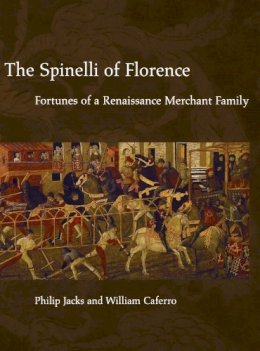
The Spinelli of Florence. Fortunes of a Renaissance Merchant Family.
Jacks, Philip; Caferro, William
The private archive of the Spinelli, acquired by Yale University’s Beinecke Library in 1988, constitutes the largest fund of information about a Florentine family anywhere outside Italy. The Spinelli of Florence tells the story of these merchants and their ascent to social and economic prominence during the fourteenth and fifteenth centuries. This book gives an intimate portrait of daily life—the worlds of papal finance, silk and wool manufacturing, and household affairs—as recorded in letters and financial ledgers preserved for two hundred years since the extinction of the male line.
The fame of this family rests largely on the extraordinary success of one individual, Tommaso Spinelli, who broke into banking through the Alberti and Borromei organizations, later to serve as depository general under Pope Eugenius IV and financial officer to three subsequent popes. Tommaso sought to raise his status in society through ties of marriage and business rather than entering the political arena, which had led to the demise and exile of older, established Florentine families, notably the Peruzzi and Alberti. Like his contemporaries, Cosimo de’Medici, Giovanni Rucellai, and Francesco Sassetti, Tommaso poured his considerable wealth into the patronage of private palaces and villas in Rome and Florence, as well as through donations to the great Franciscan church of Santa Croce. Despite his reputation for magnificence, it was Tommaso’s obeisance to the codes of religious decorum and his adherence to older artistic traditions that allowed him to commemorate himself and his family without censure.
The authors of this collaborative study, an architectural historian and economic historian, add significantly to our knowledge of private and papal banking, wool and silk manufacturing, and patronage of the arts. The Spinelli of Florence is important for scholars of history, economic history, social history, and art history.
Product Details
About Jacks, Philip; Caferro, William
Reviews for The Spinelli of Florence. Fortunes of a Renaissance Merchant Family.
